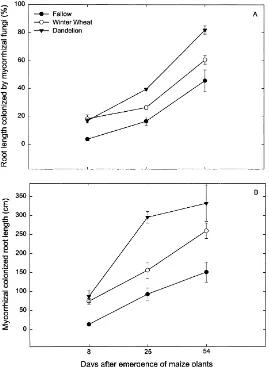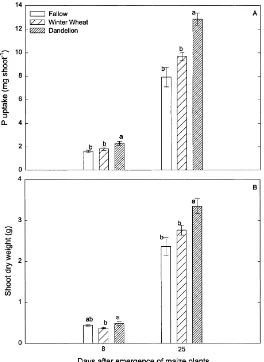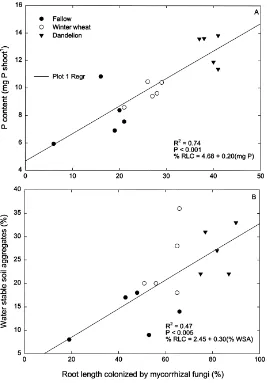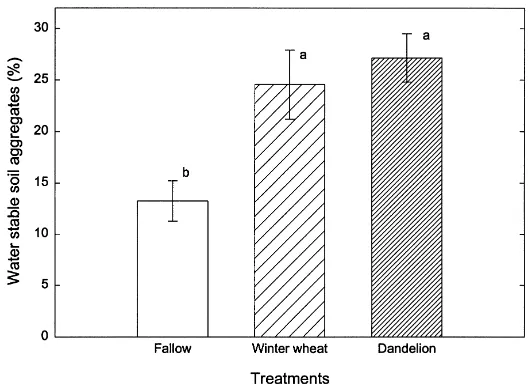The effect of dandelion or a cover crop on mycorrhiza inoculum
potential, soil aggregation and yield of maize
Z. Kabir, R.T. Koide
∗Department of Horticulture, The Pennsylvania State University, University Park, PA 16802, USA
Received 16 April 1999; received in revised form 24 August 1999; accepted 25 August 1999
Abstract
A field experiment was conducted to observe the influence of a cover crop (winter wheat, Triticum aestivum L.), and a perennial weed (dandelion, Taraxacum officinale Weber ex Wigg.), on vesicular-arbuscular mycorrhiza (VAM) inoculum potential, soil aggregation, and maize yield after one season. Mycorrhizal colonization of maize roots was higher following the autumn planting of either winter wheat or dandelion compared with fallow. In the dandelion plots maize had significantly higher P content, shoot dry weight and yield relative to the winter wheat plots. Winter wheat and dandelion both improved soil aggregation. ©2000 Elsevier Science B.V. All rights reserved.
Keywords: VA mycorrhiza; Winter wheat ( Triticum aestivum L.); Dandelion ( Taraxacum officinale Weber ex Wigg.); Aggregate stability; P content; USA
1. Introduction
Vesicular-arbuscular mycorrhizal (VAM) fungi col-onize the roots of most agricultural crops and weeds. They can significantly increase the uptake of P through extra-radical hyphae (Smith and Read, 1997). Each centimeter of well-colonized host plant root may be associated with 50–150 cm of extra-radical hyphae (Harley, 1989). This extensive hyphal network also plays an important role in soil conservation by improv-ing soil aggregation (Miller and Jastrow, 1992). Pro-duction of organic compounds by mycorrhizal hyphae and other microorganisms in the mycorrhizosphere may help to bind microaggregates into macroaggre-gates (Tisdall, 1994).
∗Corresponding author. Tel.:+1-814-863-0710;
fax:+1-814-863-6139.
E-mail address: [email protected] (R.T. Koide).
Since VAM fungi are biotrophs, the viability of hy-phae declines drastically in the absence of host plants such as during fallow (Chilvers and Daft, 1982; Addy et al., 1994) or when non-host species occur in the cropping schedule (Black and Tinker, 1977; Thomp-son, 1987; Harinikumar and Bagyaraj, 1988). This problem may be exacerbated by adverse winter con-ditions (Kabir et al., 1997). Mycotrophic winter cover crops can improve the VAM fungal inoculum potential of the soil (Boswell et al., 1998), resulting in increased P uptake by the subsequent crop (Boswell and Koide, unpubl.). Moreover, in the presence of winter cover crops, mycorrhizal spore densities have been shown to be increased (Galvez et al., 1995). Spore viabil-ity, however, may be low after winter in the absence of host plants (Dalpe, unpubl.). Thus colonized roots and hyphae appear to be the most important inoculum sources for subsequent crop establishment (Boswell et al., 1998).
The use of winter cover crops may not always be practical. Disruption of the spring planting schedule may occur (Wyland et al., 1996), and the planting and germination of the following crop may be complicated by the presence of undecomposed residues (McCalla and Duley, 1948; Papendick and McCool, 1994). The costs of growing cover crops may be prohibitive when considering seed, herbicide, labor, equipment, fuel etc. One way to receive the benefits of cover cropping without using cover crops might be to manage existing weed populations.
In particular, perennial mycotrophic weeds such as dandelion (Taraxacum officinale Weber ex Wigg.) may be effective as overwintering hosts of mycor-rhizal fungi. Dandelion can be suppressed but not killed before planting the summer crop allowing it to be used in subsequent years as a winter cover. The present study was conducted to test the hypothesis that both winter wheat and dandelion grown over the winter will result in greater VAM fungal inoculum potential, soil aggregation and subsequently maize P content and yield in comparison with a fallow treatment after one season.
2. Material and methods
The experiment was conducted at the Pennsylvania State University R.A. Larson Agricultural Research Center, Rock Springs, PA, USA. The soil is a silty
loam with a NaHCO3-extractable P concentration of
approximately 12.10mg g−1 of soil. The pH (water)
of the soil was 6.38. In the summer of 1997 the entire field was fallow.
A randomized complete block design with three treatments and five replications was used. All plots
were 5 m×6 m. The treatments were winter wheat
(Triticum aestivum L. cv. ‘Freedom’), dandelion (T.
of-ficinale Weber ex Wigg.; Valley Seed Service, Fresno,
CA, USA) and fallow. On 5 September 1997, the entire field was disked. Winter wheat and dandelion seeds were broadcast on 9 September, at the rate of
2.8 kg and 1.5 kg ha−1, respectively. The fallow plots
received no seeds.
On 15 October 1997, weed species were identified and percent cover estimated in five, 22 cm diame-ter circles placed randomly in each plot. The weeds were Thlaspi arvense L., Lamium amplexicaule L.,
Chenopodium album L., Portulaca oleracea. L., Med-icago sp., Centaurea sp., Stellaria sp., Polygonum pen-sylvanicum L. and Poaceae spp. in both dandelion and
winter wheat plots. Thlaspi arvense and Lamium
am-plexicaule comprised approximately 90% of the weeds
present. Approximately 19–30% of the surface area of the dandelion and winter wheat plots was bare ground. The fallow treatment was lightly hoed to remove weeds resulting in approximately 95% bare ground.
On 14 May 1998, NH4NO3 was broadcast on the
surface of each plot at the rate of 450 kg ha−1. On 15
May, all the plots were disked to suppress the vege-tation in the winter wheat and dandelion plots. On 18 May, maize (Zea mays L. cv. ‘Temptation’) was sown in rows spaced 75 cm apart in each plot at the rate of
54 000 seeds ha−1. Seedlings emerged by 24 May.
Root samples were taken randomly from each plot at Day 8 (1 June), Day 25 (18 June) and Day 54 (29 July) after emergence. Four plants were selected from each plot on each date and the entire root system was excavated. Shoot samples were also taken randomly from each plot at Day 8 (1 June) and 25 (18 June) after emergence. Shoot and root samples from each plot were pooled. At Day 54 ear leaves from four randomly-selected plants were taken from each plot. These from each plot were pooled for nutrient analysis. At the end of the season (13 August, 1998), plants and ears were counted and height of the plants were
measured from a 4 m2 area randomly located at the
center of each plot, avoiding places where earlier har-vests occurred. Marketable ears per plot were also counted. Ears were considered marketable when free
from damage and full of grain (<8% of the top of
the ear was without grain). Shoots, ear leaves and ears from each of the plots were oven dried separately at
65◦C to constant weight.
Oven-dried shoot, ear leaf and grain samples were weighed and ground to pass a 0.5 mm sieve.
Sam-ples were digested for 1 h at 400 ◦C using
concen-trated H2SO4and 30% H2O2. Phosphorus
concentra-tions were determined by the method of Watanable and Olsen (1965) and N concentration by the Nessler method (Jensen, 1962).
autoclaved in 10% KOH for 15 min and stained with trypan blue for at least 24 h. Total root length and my-corrhizal colonization was assessed by the line inter-sect method (Koide and Mooney, 1987).
The proportion of soil as water stable aggregates was determined according to Kemper and Rosenau (1986) as modified by Angers and Mehuys (1993). Five grams of field-moist soil between 1 and 2 mm
were spread on a 250mm sieve. The height of the
sieve of the wet sieve apparatus (Five Star Scien-tific, Twin Falls, ID, USA) was adjusted so that all the soil remained immersed in water during its move-ment (35 vertical strokes per min for 10 min). Soil
Fig. 1. Mean percent of root length colonized by (A) mycorrhizal fungi and (B) mycorrhizal colonized root length at Day 8, 25 and 54 after emergence of maize plant in the fallow, winter wheat and dandelion plots . Error bars are±1 s. e. m., n=5.
particles that passed through the sieve were consid-ered to be the soil fraction that is unstable in wa-ter. Soil remaining on the sieve was dispersed with 25 ml 5% sodium hexa-metaphosphate to separate the water-stable soil fraction from coarse materials. The proportion of water-stable soil aggregation was calcu-lated as a percentage of weight of the stable fraction to the total soil weight.
Statistical analysis was performed using the pro-grams of Statgraphics Plus (STSC, 1991). Data were analyzed using single and two-factor analyses of variance. Least significant difference (LSD) tests were
Linear regression analyses were performed to estab-lish the correlation between percent of root length colonized by mycorrhizal fungi and maize shoot P content (at Day 8 and 25 after emergence), and be-tween percent of root length colonized by mycorrhizal fungi and percent of water stable soil aggregates (Day 54 after maize emergence).
3. Results
There was no significant difference in the percent of bare ground in the winter wheat and the
dande-Fig. 2. (A) Mean shoot P content and (B) shoot dry weight at 8 and 25 days after emergence of maize plants in the fallow, winter wheat and dandelion plots. Error bars are±1 s. e. m., n=5.
lion plots on 15 October 1997. This averaged 27% in the winter wheat and 26% in the dandelion plots. The number of dominant weeds (Thlaspi arvense and
Lamium amplexicaule) was not significantly different
between winter wheat and dandelion plots. On aver-age, 33 T. arvense and 13 L. amplexicaule were present
per m2in the winter wheat plots and 39 T. arvense and
20 L. amplexicaule were present in the same area in the dandelion plots. The density of all the other iden-tified weeds taken together (excluding T. arvense and
L. amplexicaule) was significantly higher in the
dan-delion plots (11 plants m−2) than in the winter wheat
Table 1
Mean (±1 s. e. m.a) phosphorus concentrations (%) of various parts of maize plants
Treatments 8-day shoot 25-day shoot Ear leaf Grain
Fallow 0.37±0.01bb 0.34±0.01b 0.20±0.01b 0.34±0.02a
Winter wheat 0.50±0.02a 0.35±0.01b 0.23±0.04b 0.35±0.01a
Dandelion 0.47±0.02a 0.39±0.01a 0.35±0.02a 0.36±0.01a
aStandard error mean.
bDifferent letters indicate a significant (p
<0.05) difference between treatment means, n=5.
There was a significant interaction between treat-ment and sampling time for percent of root length colonized by mycorrhizal fungi and colonized root length. Therefore, for simplicity, the effects of treat-ment at each sampling period are described. Percent of root length colonized by mycorrhizal fungi (Fig. 1A) and colonized root length (Fig. 1B) were signifi-cantly greater in the winter wheat and dandelion plots than in the fallow plots 8 d after maize emergence. At Day 25 and 54 after maize emergence, percent of root length colonized by mycorrhizal fungi and colo-nized root length were higher in the dandelion than in the winter wheat plots and fallow plots were always significantly lower.
Maize shoot P content was significantly higher in the dandelion plots than in the winter wheat and fal-low plots 8 and 25 days after emergence (Fig. 2A). Phosphorus concentrations of maize shoots were sig-nificantly higher in both winter wheat and dandelion plots than in the fallow plots at Day 8 (Table 1). How-ever, only dandelion plots differed from fallow plots in shoot P concentration at Day 25. The same was true for the ear leaf. The percent of maize root colonized by mycorrhizal fungi was not significantly correlated with shoot P content at Day 8 (results not shown) but
it was significantly (R2=0.75 and p<0.0001)
corre-lated at Day 25 (Fig. 3A). Phosphorus concentration
Fig. 4. Mean percent of water stable aggregates at 54 days after emergence of maize plants in the fallow, winter wheat and dandelion plots. Error bars are±1 s. e. m., n=5.
of grain was not significantly affected by treatment (Table 1). Shoot, ear leaf and grain N concentrations were also not significantly influenced by treatment. Mean shoot N concentration was 3.31% at Day 8 and 5.62% at Day 25 after maize emergence. Shoot ear leaf N concentration was 1.57% and mean grain N concentration was 1.56%.
Fifty-four days after maize emergence, the percent of soil as water stable aggregates was significantly greater in the winter wheat and dandelion plots than in the fallow plots (Fig. 4). The percent of soil as water stable aggregates was also positively correlated
(R2=0.47 and p<0.005) with the percent of root
length colonized by mycorrhizal fungi at Day 54 of maize growth (Fig. 3B).
At Day 8, maize shoot dry weight was significantly lower in the winter wheat plots than in the dande-lion plots. Maize shoot dry weight was intermediate in the fallow plots (Fig. 2B). At Day 25, maize shoot dry weight was significantly greater in dandelion plots (by 30%) than in either winter wheat or fallow plots. Maize shoot dry weight was also significantly corre-lated with the percent of root length colonized by
my-corrhizal fungi at Day 25 (R2=0.64 and p<0.0001).
Table 2
Mean (±1 s. e. m.) of height, grain weight, plant density and ear production for maize plants
Treatments Height (cm) Grain dry wt. plant−1 Plants ha−1 Marketable ears plant−1
Fallow 168±2.2ba 29.13±1.2b 48545±1695a 0.56±0.04b
Winter Wheat 162±0.8b 28.93±1.3b 31255±2899b 0.76±0.10ab
Dandelion 174±2.1a 35.33±0.6a 45885±2443a 0.92±0.049a
aDifferent letters indicate a significant (p
<0.05) difference between treatment means, n=5.
Dandelion plots had significantly greater maize height than winter wheat plots (Table 2). Maize plant density was also significantly greater in the dande-lion plots than in the winter wheat plots (by 46%). Maize dry weight per plant and marketable ears per plant were 22 and 75% significantly greater, respec-tively, in the dandelion plots than in the winter wheat plots. The mean number of ears per plant was not significantly different among the treatments.
4. Discussion
The work here shows for the first time that a myc-orrhizal perennial weed (dandelion) could be used as a winter vegetative cover to improve the mycorrhizal inoculum potential and establishment of the follow-ing crop of maize. Dandelion also had a more posi-tive effect on mycorrhizal colonization, P content and growth of a subsequent maize crop than winter wheat. Our conclusions, however, are based on results from one season and one field. Dandelion develops an ex-tensive root system and in the years following the ini-tial planting it may begin to compete with the main crop. Careful management of any weed would there-fore be necessary in order to have its beneficial effects outweigh its detrimental ones.
Eight days after the emergence of maize, percent of root length colonized by mycorrhizal fungi was not re-lated to shoot P content. At this stage of maize growth, shoots were probably receiving P primarily from their seeds (Evans and Miller, 1988) and thus during early development, mycorrhizal colonization may not con-tribute much to shoot P content. By Day 25, however, percent of root length colonized by mycorrhizal fungi was significantly correlated with shoot P content, in-dicating that plants were probably more dependent on VAM fungi.
VAM hyphal networks can increase soil aggregate stability (Miller and Jastrow, 1992). Thus it was not surprising to find that the percent of soil as water sta-ble aggregates was greater in the winter wheat and dandelion plots than in the fallow plots in which my-corrhizal inoculum potential was lower. Mymy-corrhizal hyphae may have contributed to improved soil aggre-gation by the production of glomalin, a glycoprotein which may act as a cementing agent for soil particles (Wright and Upadhaya, 1996). Likewise, mycorrhizal hyphae may directly improve soil aggregates by pro-viding a skeletal structure which physically binds soil particles (Miller and Jastrow, 1992). VAM fungi also may indirectly improve soil structure by providing carbon for other microorganisms which produce soil binding chemicals. Andrade et al. (1998) found that total bacteria and P solubilizing bacteria were greater in the presence of VAM fungi. Because maize root length was not significantly different among the treat-ments at any period of sampling, differences in soil aggregation do not appear to be influenced by maize roots. However, the presence of old wheat and dande-lion roots may have improved soil aggregate stability. Seeding establishment was worse in the wheat plots than in the dandelion plots. This was probably because winter wheat plants were quite vigorous and the spring disking did not chop the winter wheat stocks suffi-ciently. In contrast, dandelion plants were relatively soft when they were disked in the spring and thus they were easily chopped. Consequently, the planting of the maize seeds at the appropriate soil depth was easier in the dandelion plots.
did not impede maize germination and promoted my-corrhizal inoculum potential to a greater extent. In practice, the planting of weeds may not be necessary, but proper management of some existing mycorrhizal weed populations, such as dandelion, could be prof-itable both financially and ecologically.
Acknowledgements
The authors thank Dr. Durland L. Shumway for suggesting this project and acknowledge the financial support of the A.W. Mellon Foundation. Thanks are also expressed to the staff of the Penn State Horticul-ture Research Farm for technical assistance and Paul D. Johnson and Melissa D. Goff for improvements to the manuscript.
References
Addy, H.D., Schaffer, G.F., Miller, M.H., Peterson, R.L., 1994. Survival of the external mycelium of a VAM fungus in frozen soil over winter. Mycorrhiza 5, 1–5.
Andrade, G., Mihara, K.L., Linderman, R.G., Bethlenfalvay, G.J., 1998. Soil aggregation status and rhizobacteria in the mycorrhizosphere. Plant and Soil 202, 89–96.
Angers, D.A., Mehuys, G.R., 1993. Aggregate stability to water. In: Carter, M.R. (Ed.), Soil Sampling and Methods of Analysis, Canadian Society of Soil Science. Lewis Publishers, Boca Raton, pp. 651–657.
Black, R.L.B., Tinker, P.B., 1977. Interactions between effects of vesicular-arbuscular mycorrhiza and fertilizer phosphorus on yields of potatoes in the field. Nature 267, 510–511. Boswell, E.P., Koide, R.T., Shumway, D.L., Addy, H.D., 1998.
Winter wheat cover cropping, VA mycorrhizal fungi, and maize growth and yield. Agric. Ecosyst. Environ. 67, 55–65. Chilvers, M.T., Daft, M.J.F., 1982. Effects of low temperature on
development of the vesicular-arbuscular mycorrhizal association between Glomus caledonium and Allium cepa. Trans. Brit. Mycol. Soc. 79, 153–157.
Evans, D.G., Miller, M.H., 1988. Vesicular-arbuscular mycorrhizas and the soil-disturbance-induced reduction of nutrient absorption in maize I. Casual relations. New Phytol. 111, 67– 74.
Galvez, L., Douds Jr., D.D., Wagoner, P., Longnecker, L.R., Drinkwater, L.E., Janke, R.R., 1995. An overwintering cover crop increases inoculum of VAM fungi in agricultural soil. Am. J. Altern. Agric. 10, 152–156.
Harinikumar, K.M., Bagyaraj, D.J., 1988. Effect of crop rotation on native vesicular arbuscular mycorrhizal propagules in soil. Plant and Soil 110, 77–80.
Harley, J.L., 1989. The significance of mycorrhiza. Mycol. Res. 92, 129–139.
Jensen, W.A., 1962. Botanical Histochemistry. Freeman, San Francisco, CA, 408 pp.
Kabir, Z., O’Halloran, I.P., Hamel, C., 1997. Overwintering survival of arbuscular mycorrhizal hyphae is favored by attachment to roots but diminished by disturbance. Mycorrhiza 7, 197–200.
Kemper, W.D., Rosenau R.C., 1986. Aggregate stability and size distribution. In: Klute, A. (Ed), Method of Soil Analysis. Part I. 2nd ed. American Society of Agronomy, Madison, WI., pp 425–442.
Koide, R.T., Mooney, H.A., 1987. Spatial variation in inoculum potential of vesicular-arbuscular mycorrhizal fungi caused by formation of gopher mounds. New Phytol. 107, 173–182. McCalla, T.M., Duley, F.L., 1948. Stubble mulch studies III.
Influence of soil microorganisms and crop residues on the germination, growth and direction of root growth of corn seedlings. Soil Sci. Soc. Am. Proc. 14, 196–199.
Miller, R.M., Jastrow, J.D., 1992. The role of mycorrhizal fungi in soil conservation. In: Behtlenfalvay, G.J., Linderman, R.G. (Eds.), Mycorrhizae in Sustainable Agriculture. ASA Special Publication 54, Am. Soc. of Agronomy, Madison, WI., pp. 29–44.
Papendick, R.I., McCool, D.K., 1994. Residues management strategies-pacific northwest. In: Hatfield, J.L., Stewart, B.A. (Eds.), Crop Residue Management. Lewis, Boca Raton, pp. 1–14
Smith, S.E., Read, D.J., 1997. Mycorrhizal Symbiosis. Academic Press, London, pp. 126–160.
STSC, 1991. Statgraphics Statistical Graphics System Version 5.1. STSC, Rockville, MD.
Thompson, J.P., 1987. Decline of vesicular-arbuscular mycorrhizae in long-fallow disorder of field crops and its expression in phosphorus deficiency of sunflower. Aust. J. Agric. Res. 38, 847–867.
Tisdall, J.M., 1994. Possible role of soil microorganisms in aggregation in soils. Plant and Soil 159, 115–121.
Watanable, F.S., Olsen, S.R., 1965. Test of an ascorbic acid method for determining phosphorus in water and NaHCO3 extracts from soil. Soil Sci. Soc. Proc. 29, 677.
Wright, S.F., Upadhaya, A., 1996. Extraction of an abundant and unusual protein from soil and comparison with hyphal protein from arbuscular mycorrhizal fungi. Soil Sci. 161, 575–586. Wyland, L.J., Jackson, L.E., Chaney, W.E., Klonsky, K., Koike,




